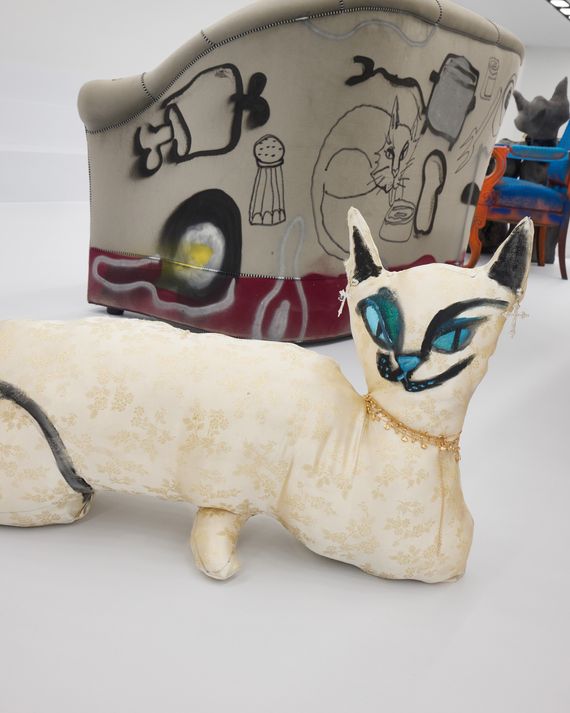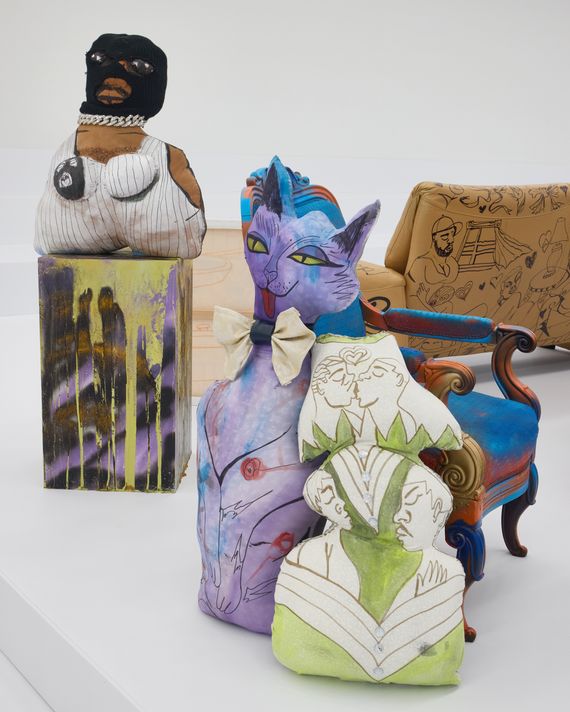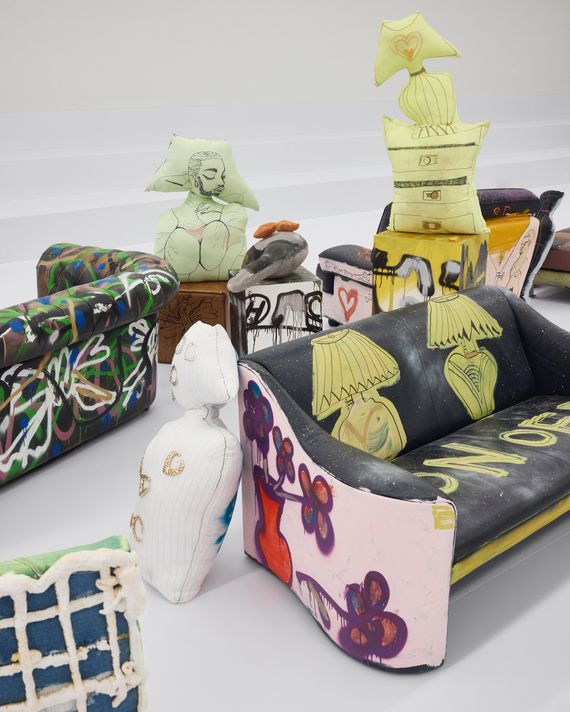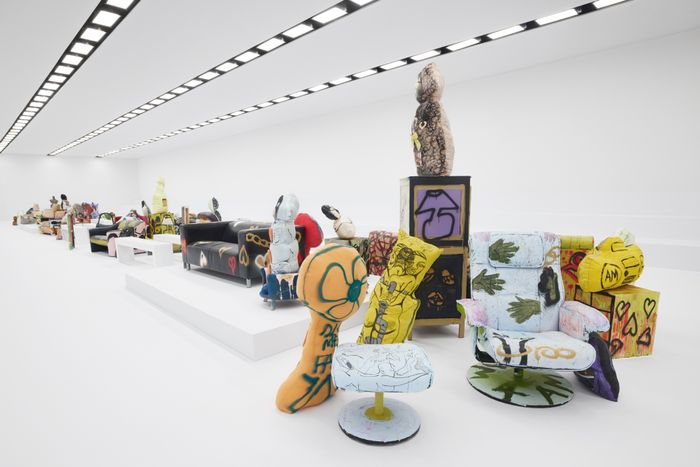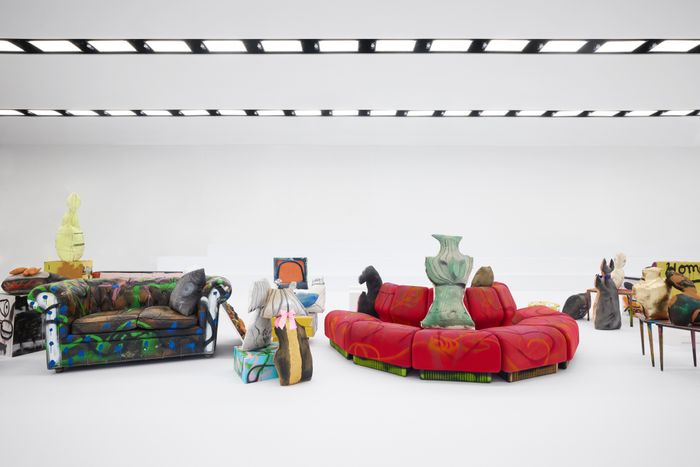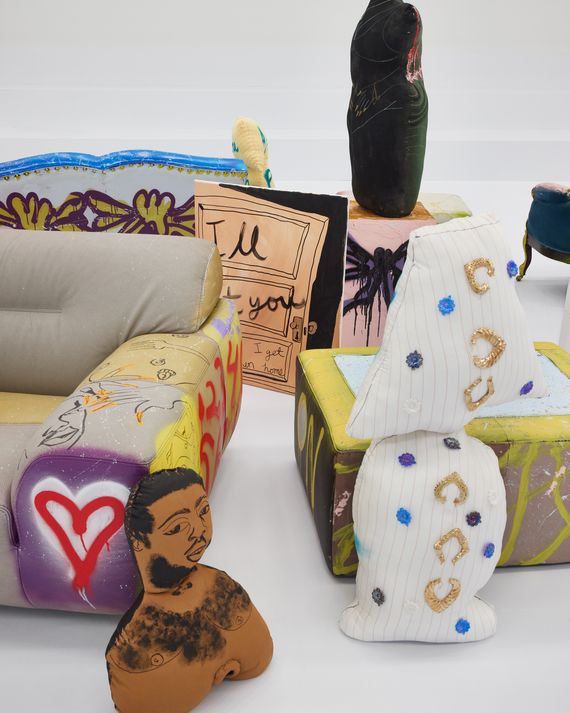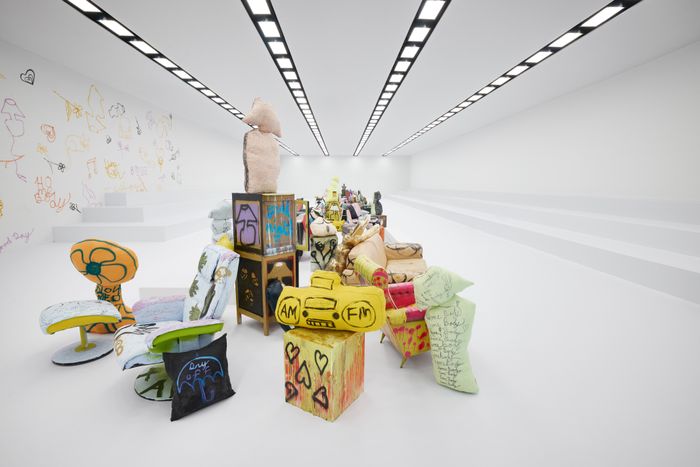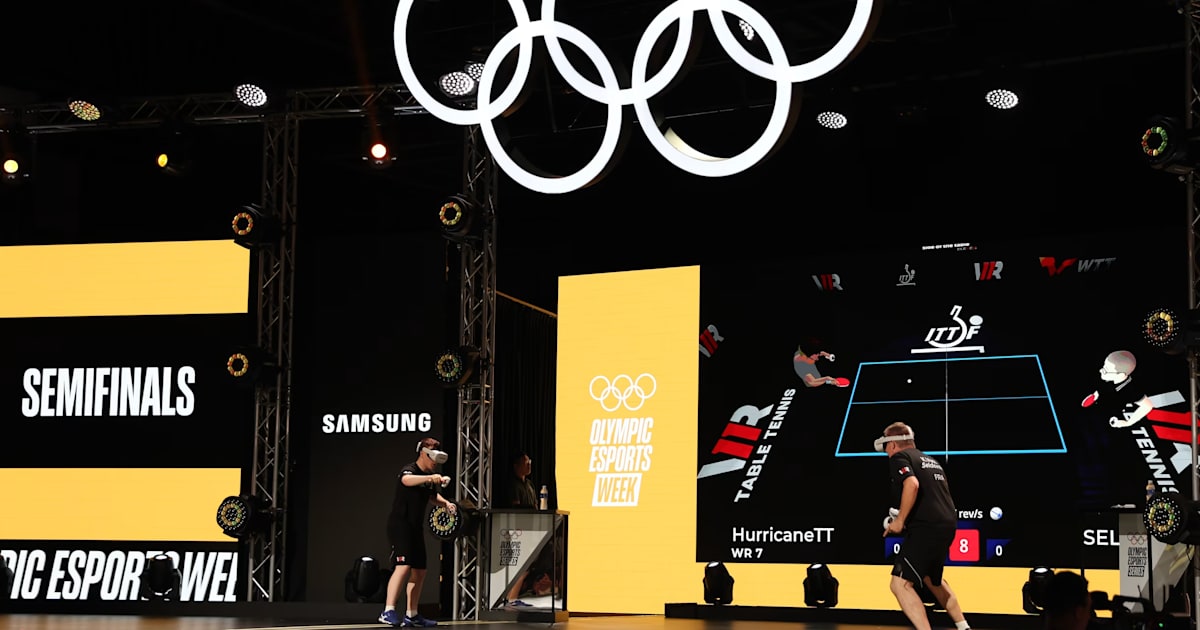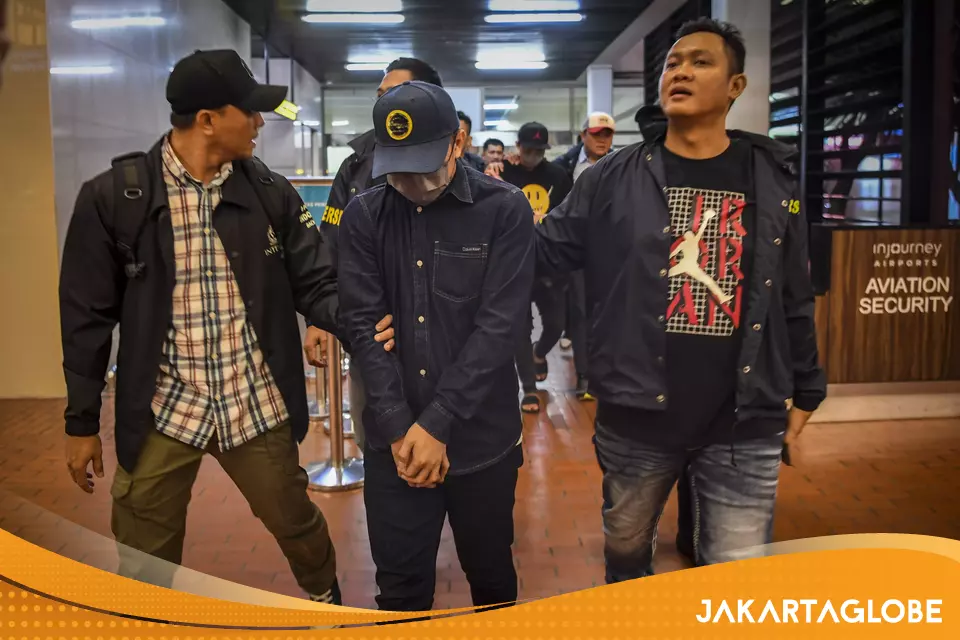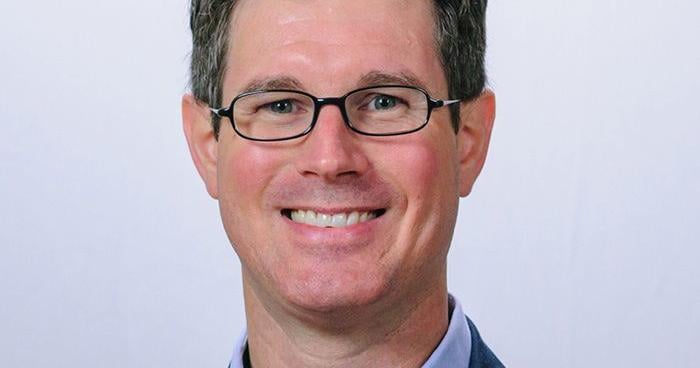Fashion
The Fashion Week Runway Art You Might Have Missed
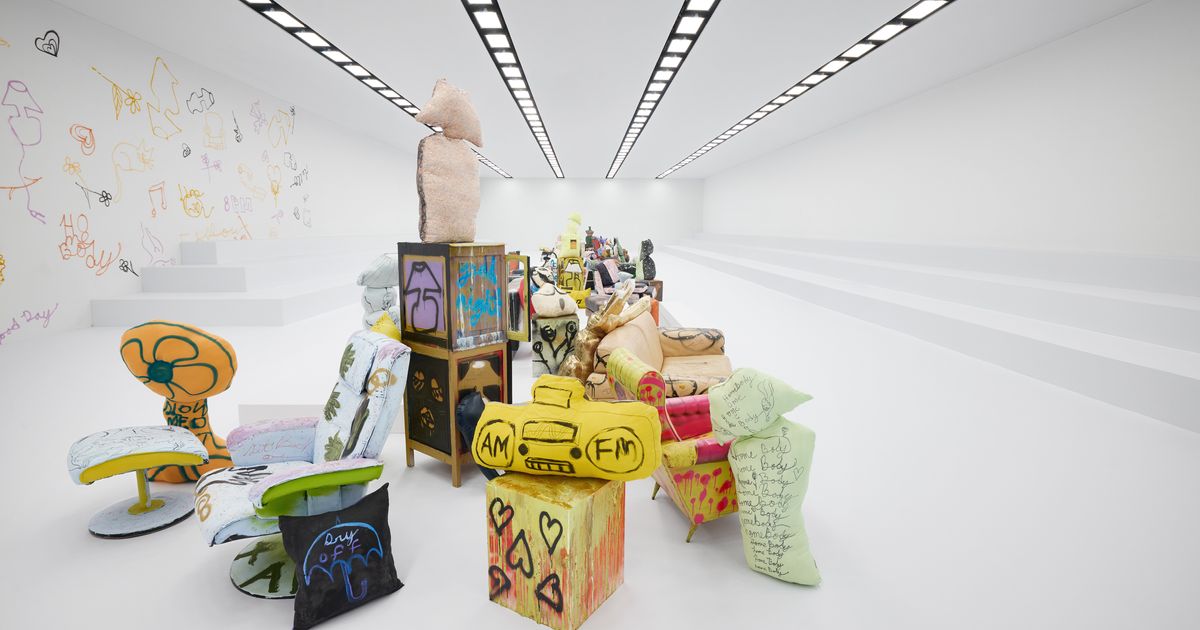
Photo: Courtesy of Acne Studios
Upon entering the Paris Observatory for Acne Studios’ Paris Fashion Week show, I was met with attendees posing on couches, a seemingly “normal” scene. But upon further inspection, I realized there were drawings on these couches, with sayings like “Homebody,” and a pan of eggs and a salt and pepper shaker. There were also plushies in the shapes of animals, laps, and the torso of a man. My eyes immediately went to an embroidered pillow that looked like something my grandmother would have sitting in her basement, except it wasn’t your average pillow; it was the shape of a cat with facial drawings and gold jewelry draped over it. What does this have to do with the show? I thought to myself. It was a chaotic display of maximalism.
“This is just the coolest,” a guest said before posing in front of the set design. The showgoers didn’t know this was an art installation meant to make them feel “a bit overwhelmed,” according to the artist, Jonathan Lyndon Chase. Acne Studios had asked Chase, known for their expressionism and visual language in painting, poetry, sculpture, and many other art forms, to create an installation that doubled as a show set.
Photo: Courtesy of Acne Studios
A few hours before the show, Chase walked us through the installation. “I want them to take notice of the different textures and patterns,” they said of the attendees. This is not only the first time the Philadelphia-based artist has designed a set for a fashion show; it’s also their first time in Paris. They’ve been here for almost the whole of September, sourcing art for the installation and sketching and planning for the show. Walking around the space, feeling and touching the objects and dissecting them from front to back, Chase tells the Cut about their process in making the art.
Photo: Courtesy of Acne Studios
What’s the point of this exhibition?
I want people to feel, pun intended, at home or to be reminded of their homes. And for our community, queer and Black people, I want them to really feel a sense of power. It’s really important for me to talk about these really more private, tender, raw interior moments. This one plush object is a person in a private interior moment, but if we turn it over and look on the other side, there’s another person who represents their outside self. With this body of work, this installation, I’m really talking about the public, the private, and the liminal.
Did you see the Acne collection before or after you started designing?
I saw it kind of midway in, which was great because I went in a little fresh. We talked a lot about alienness and the mysticlike pleasures, then I started everything off with a sketch or a group of drawings. I started thinking about picking out materials and drawing the ideas that I wanted to have: lamps, vacuums, and sinks. Then when I did get to see the beautiful collection, it started to translate a lot more into deciding what specific fabric I wanted to use.
Photo: Courtesy of Acne Studios
What kind of fabrics did you start sourcing?
I started incorporating decorative pieces like this iconic bow that I am absolutely obsessed with; it acts sometimes as more of a complement and a decorative piece. It’s a great way to tie in something that’s soft and fleshy like a body. The clothing is really architectural and an extension of this. Before I saw the collection, I was working with a lot of jewelry like gold metallic things to add another surface. Jewelry is one of my most favorite things to use in the studio. I’m really a maximalist being introduced to all of these new ways of installing my work. It was like a feast to just go all out and use a lot of things from my archive.
Photo: Courtesy of Acne Studios
Draping in clothes often imitates the draping of household items like curtains, and I know we’re expecting some draping in this show. How did you want to build this synergy between the installation and the clothes?
There’s lots of drape and flow-y pieces. These objects that would normally be hard are kind of unexpectedly or inadvertently made in the soft sort of way. There’s one that has this kind of lace and crochet; there’s lots of figures that have fishnets and things like that. Within the collection, there’s lots of soft or more delicate kinds of materials in it, paired with the really rough and washy objects. I wanted the installation to feel the same way.
Photo: Courtesy of Acne Studios
There’s also graffitilike art on the walls. Tell me about that.
I’m super-stoked about this because it’s the biggest drawing language that I’ve done, and it’s done with spray paint. I’m bringing in something that’s from my outside world that we recognize into the inside world. You’ll see lots of the symbols of my chronography here. It is really me trying to get an immersive experience but then also give you room to just kind of move through it.
Photo: Courtesy of Acne Studios
Feeling at home is such an interesting theme for a fashion show. What’s your idea of feeling at home?
A place where you’re doing lots of self-reflection, meditation; you feel safe and you can just be messy and hold all of these multitudes of yourself that, in the outside world, we don’t always see. When you’re in your domestic safe space, it’s this moment to just really be kind of softer. The world calls for us to be very, very hard, so it’s like this balancing act or this conscious effort to try to be as genuine as possible to yourself.
Photo: Courtesy of Acne Studios

